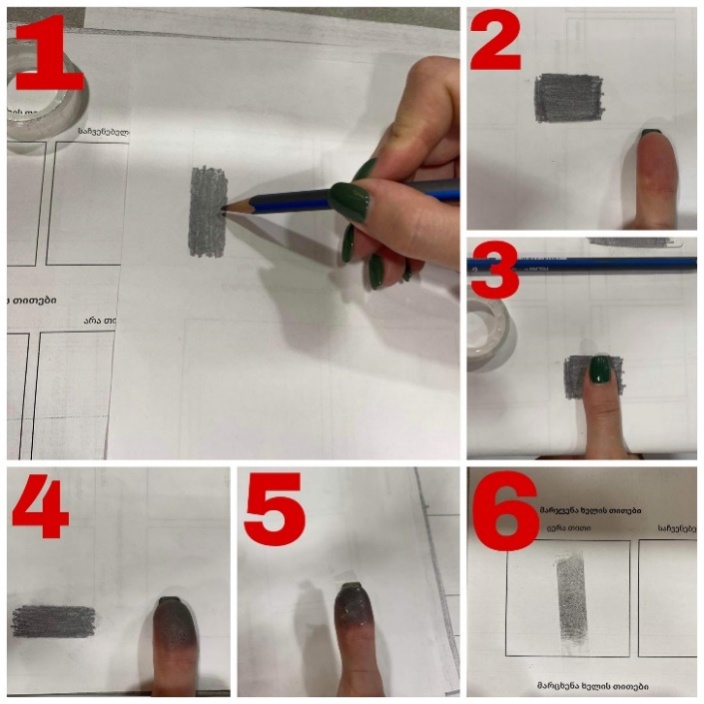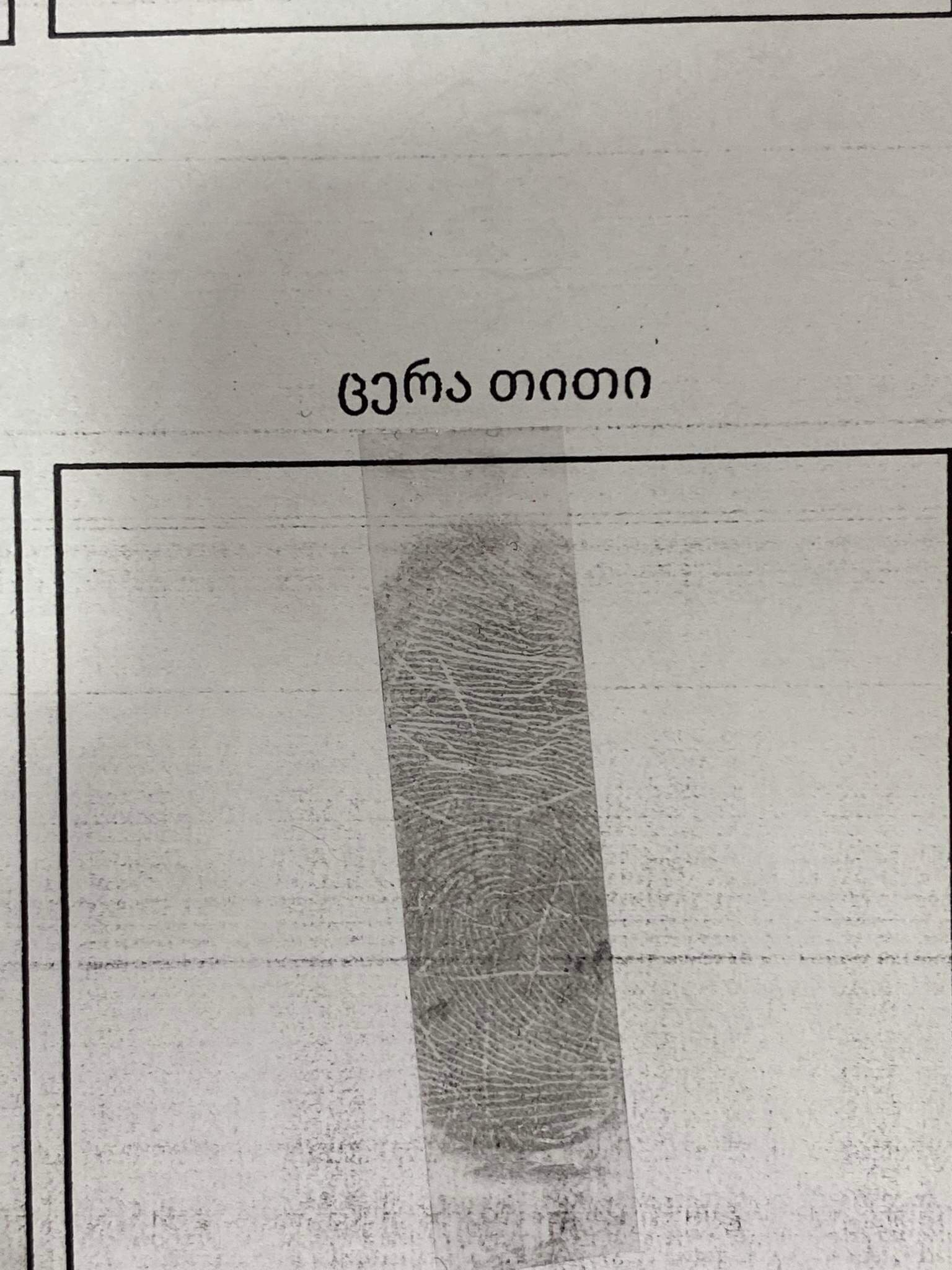1. Introduction
Fingerprints due to their unique characteristics of absolute individuality are used as one of the significant methods of identification of individuals (1) in both civil and criminal cases (2), as well it are considered as significant human biometric traits, accordingly (3). Fingerprint formation initiates during embryonic development and remains permanent throughout the entire lifespan of human beings (4), (5), (6). Due to the Structural characteristics of a living being, there is no possibility of finding two identical parts of the body. This fact is defined by the influence of external and internal factors and It’s natural that those factors affect the development of particular organs, among them the human skin epidermis. Fingerprints developed on the skin are not possible to duplicate, because of this there is no chance to coincide even in identical tweens (7), (8). The uniqueness of the skin certainly manifests itself in the period of early embryonic development. Fingerprints are formed in the 10th to 11th week of fetal development and continue formation in the second trimester of embryogenesis. From a scientific viewpoint, fingerprints are an interesting research object as one of the additional methods of gender identification. The relief of fingerprints and their unique individuality have been triggering great interest before and triggers nowadays within a wide board of scientists, however, despite many studies, the exact method for gender identification based on fingerprints has not yet been fully accomplished. Various scientific researches indicate that on the relief of the finger in the majority of females can be observed so-called „white lines“, that are supposedly possible to be used for gender identification (9), (10). The main goal of the current study was to identify gender based on fingerprints in the Georgian population. In previous research, the profile of fingerprints has been studied in the same population (11).
2. Research materials and methods
In the current study, the fingerprints of 270 individuals have been studied within two age categories: 12-24 and 40-70 age groups. Research participants were provided with information about the survey before obtaining their consent, that related to their participation in the current study. Involvement of the volunteers below ≤18 has been done with the consent of their parents. Research materials were collected in 2021-2022.
One of the factors that indicated a decline in participation in the survey was the damaged relief of the finger, suggesting that not everyone had equal access to fingerprinting. Fingerprinting was only available on the thumbs of right and left hands during the survey.
During the research, a B2-type pencil, A4 sheet, and adhesive tape have been used. The research procedure is presented in the illustration below. After obtaining fingerprint samples, white lines were observed (Fig. 1,2). The obtained material was studied and processed statistically. Ratios between groups were compared with a Chi-square analysis of proportions. The level of statistical significance was set at 0.05.

Figure 1. The main steps of fingerprinting

Figure 2. The white lines on the fingerprint pattern.
3. Results
Out of a total of 270 individuals, 215 (79.63%) fingerprint samples were from individuals within the 12-24 age group, among them 111 (51.63%) being female and 104 (48.37%) male. The remaining 55 (20.37%) individuals belonged to the 40-70 age group, in which 25 (45.46%) individuals were males and 30 (54.54%) were females (Table 1). The chi-square statistic is 0.1494. The p-value is .699096.
Table 1. Participants in the current study
Participants age categories | n | % | Gender | N | % |
12-24 age group | 215 | 79.63 | Female | 111 | 51.63 |
Male | 104 | 48.37 | |||
40-70 age group | 55 | 20.37 | Female | 30 | 54.54 |
Male | 25 | 45.46% | |||
Total | 270 | 99.97 | 270 |
In the table given below (Table 2) the number of white lines in correlation with gender is differentiated, and it is certainly obvious, that, 54% of female representatives have white lines on their right and left thumbs fingerprints if we do not consider the number of additional white lines that were found only on the right or left thumb.4,96% of the females (n=7) White lines presented only on right thumb; 9,22% (n=13) case of females have white lines only on left thumb. 31,21% (n=44) case females do not have any white lines on both fingers. The majority of the males (60,47) don’t have white lines on the fingers (78/129). The chi-square statistic is 38.3783. The p-value is < 0.00001. The result is significant at p < .05.
Table 2. Comparison of white lines according to gender
Number of white lines on both fingers | Number of white lines only on Right thumb | Number of white lines only on left thumb | Not presented on non of the fingers | Total | ||||||
n | % | n | % | n | % | n | % | n | % | |
Female | 77 | 54,61 | 7 | 4,96 | 13 | 9,22 | 44 | 31,21 | 141 | 100 |
Male | 23 | 20,93 | 10 | 7,75 | 14 | 10,85 | 78 | 60,47 | 129 | 100 |
Table 3 presents the domination of white line amounts in the 12 – 24 age females' fingerprints, except of this it should be also mentioned that the number of white lines was more on the left thumbs of individuals (Table 3). The chi-square statistic is 41.2033. The p-value is < 0.00001. The result is significant at p < .05.
Table 3. Comparison of white lines according to gender in the 12 – 24 age categories.
Number of white lines on both fingers | Number of white lines only on Right thumb | Number of white lines only on left thumb | Not presented on non of the fingers | Total | ||||||
n | % | n | % | n | % | n | % | n | % | |
Female | 18 | 60 | 0 | 0 | 0 | 0 | 12 | 40 | 30 | 100 |
Male | 1 | 4 | 5 | 20 | 4 | 16 | 15 | 60 | 25 | 100 |
In Table 4, besides the excess number of white lines in the females, a new occasion was also observed, on the fingerprints of the female representatives aged 40-70, white lines were visible either on both thumbs or none. Regarding males, here the statistics are again decreasing compared to the females (Table 4). Only 28,83% (32/111) of the studied females don’t have white lines in the fingerprint pattern of thumbs. 73 studied males out of 104 (70,19%) don’t have any white lines.
Table 4. Comparison of white lines according to gender in the 40-70 age categories.
Number of white lines on both fingers | Number of white lines only on Right thumb | Number of white lines only on left thumb | Not presented on non of the fingers | Total | ||||||
n | % | n | % | n | % | n | % | n | % | |
Female | 59 | 53,15 | 7 | 6,31 | 13 | 11,71 | 32 | 28,83 | 111 | 100 |
Male | 16 | 15,38 | 5 | 4,81 | 10 | 9,62 | 73 | 70,19 | 104 | 100 |
4. Conclusion
Based on the conducted research and obtained results, we can conclude, that in the fingerprints of a total 270 studied individuals, an identification marker – white lines have been revealed in 71.17% of females, while in males it was equaled to 29.81 % only. In addition to the overall indicator, the above-mentioned marker was more obvious in the 40-70 age category, since the current research was conducted in two, 12-24 and 40-70 age groups. Of course, the current research method of fingerprinting is not a hundred percent trustful indicator of gender identification, However, the obtained results of conducted research allow us to use the fingerprint white line ratio as an additional gender identification method.
References
[1]. Kuznetsov D. Identification of a Personality. Siemens E, Mehtiyev AD, Syryamkin VI, Yurchenko AV, editors. MATEC Web Conf. 2018;155:01018.
[2]. Meier RJ. Anthropological dermatoglyphics: A review. Am J Phys Anthropol. 1980;23(S1):147–78.
[3]. Syryamkim VI, Kuznetsov DN, Kuznetsova AS. Biometric identification. IOP Conf Ser Mater Sci Eng. 2018 May;363:012005.
[4]. Lh A, Mg T. Embryogenesis and Applications of Fingerprints- a review. Kitahara S, editor. Int J Hum Anat. 2017 Jun 27;1(1):1–8.
[5]. Wertheim K. EMBRYOLOGY AND MORPHOLOGY OF FRICTION RIDGE SKIN. :26.
[6]. Kücken M, Newell AC. A model for fingerprint formation. Europhys Lett EPL. 2004 Oct;68(1):141–6.
[7]. Tao X, Chen X, Yang X, Tian J. Fingerprint Recognition with Identical Twin Fingerprints. Zuo XN, editor. PLoS ONE. 2012 Apr 27;7(4):e35704.
[8]. Jain AK, Prabhakar S, Pankanti S. On the similarity of identical twin fingerprints. Pattern Recognit. 2002 Nov;35(11):2653–63.
[9]. Chukwuma AL. Gender Prediction from the Primary Fingerprint Pattern: A Study among Medical Students in Ambrose Alli University, Ekpoma. Biomed J Sci Tech Res [Internet]. 2020 Jul 21 [cited 2021 Sep 9];29(1). Available from: https://biomedres.us/fulltexts/BJSTR.MS.ID.004739.php
[10]. Verma M, Agarwal S. Fingerprint Based Male-Female Classification. In: Corchado E, Zunino R, Gastaldo P, Herrero Á, editors. Proceedings of the International Workshop on Computational Intelligence in Security for Information Systems CISIS’08 [Internet]. Berlin, Heidelberg: Springer Berlin Heidelberg; 2009 [cited 2021 Sep 20]. p. 251–7. (Advances in Soft Computing; vol. 53). Available from: http://link.springer.com/10.1007/978-3-540-88181-0_32
[11]. Marina Nagervadze, Jilda Gobadze , Sophiko Tskvitinidze, Rusudan Khukhunaishvili , Ketevan Dolidze , Leila Akhvlediani , Tea Koiava , Marina Koridze. FINGERPRINT DISTRIBUTION FEATURES IN THE POPULATION OF ADJARA (GEORGIA). International Journal of Advances in Biology (IJAB) Vol 10. No .1, February 2023.
Cite this article
Gobadze,J.;Nagervadze,M.;Tskvitinidze,S.;Khutsishvili,G.;Nagervadze,G.;Koridze,M.;Khukhunaishvili,R. (2024). Possible identification of gender based on fingerprint. Theoretical and Natural Science,62,19-23.
Data availability
The datasets used and/or analyzed during the current study will be available from the authors upon reasonable request.
Disclaimer/Publisher's Note
The statements, opinions and data contained in all publications are solely those of the individual author(s) and contributor(s) and not of EWA Publishing and/or the editor(s). EWA Publishing and/or the editor(s) disclaim responsibility for any injury to people or property resulting from any ideas, methods, instructions or products referred to in the content.
About volume
Volume title: Proceedings of the 4th International Conference on Biological Engineering and Medical Science
© 2024 by the author(s). Licensee EWA Publishing, Oxford, UK. This article is an open access article distributed under the terms and
conditions of the Creative Commons Attribution (CC BY) license. Authors who
publish this series agree to the following terms:
1. Authors retain copyright and grant the series right of first publication with the work simultaneously licensed under a Creative Commons
Attribution License that allows others to share the work with an acknowledgment of the work's authorship and initial publication in this
series.
2. Authors are able to enter into separate, additional contractual arrangements for the non-exclusive distribution of the series's published
version of the work (e.g., post it to an institutional repository or publish it in a book), with an acknowledgment of its initial
publication in this series.
3. Authors are permitted and encouraged to post their work online (e.g., in institutional repositories or on their website) prior to and
during the submission process, as it can lead to productive exchanges, as well as earlier and greater citation of published work (See
Open access policy for details).
References
[1]. Kuznetsov D. Identification of a Personality. Siemens E, Mehtiyev AD, Syryamkin VI, Yurchenko AV, editors. MATEC Web Conf. 2018;155:01018.
[2]. Meier RJ. Anthropological dermatoglyphics: A review. Am J Phys Anthropol. 1980;23(S1):147–78.
[3]. Syryamkim VI, Kuznetsov DN, Kuznetsova AS. Biometric identification. IOP Conf Ser Mater Sci Eng. 2018 May;363:012005.
[4]. Lh A, Mg T. Embryogenesis and Applications of Fingerprints- a review. Kitahara S, editor. Int J Hum Anat. 2017 Jun 27;1(1):1–8.
[5]. Wertheim K. EMBRYOLOGY AND MORPHOLOGY OF FRICTION RIDGE SKIN. :26.
[6]. Kücken M, Newell AC. A model for fingerprint formation. Europhys Lett EPL. 2004 Oct;68(1):141–6.
[7]. Tao X, Chen X, Yang X, Tian J. Fingerprint Recognition with Identical Twin Fingerprints. Zuo XN, editor. PLoS ONE. 2012 Apr 27;7(4):e35704.
[8]. Jain AK, Prabhakar S, Pankanti S. On the similarity of identical twin fingerprints. Pattern Recognit. 2002 Nov;35(11):2653–63.
[9]. Chukwuma AL. Gender Prediction from the Primary Fingerprint Pattern: A Study among Medical Students in Ambrose Alli University, Ekpoma. Biomed J Sci Tech Res [Internet]. 2020 Jul 21 [cited 2021 Sep 9];29(1). Available from: https://biomedres.us/fulltexts/BJSTR.MS.ID.004739.php
[10]. Verma M, Agarwal S. Fingerprint Based Male-Female Classification. In: Corchado E, Zunino R, Gastaldo P, Herrero Á, editors. Proceedings of the International Workshop on Computational Intelligence in Security for Information Systems CISIS’08 [Internet]. Berlin, Heidelberg: Springer Berlin Heidelberg; 2009 [cited 2021 Sep 20]. p. 251–7. (Advances in Soft Computing; vol. 53). Available from: http://link.springer.com/10.1007/978-3-540-88181-0_32
[11]. Marina Nagervadze, Jilda Gobadze , Sophiko Tskvitinidze, Rusudan Khukhunaishvili , Ketevan Dolidze , Leila Akhvlediani , Tea Koiava , Marina Koridze. FINGERPRINT DISTRIBUTION FEATURES IN THE POPULATION OF ADJARA (GEORGIA). International Journal of Advances in Biology (IJAB) Vol 10. No .1, February 2023.









